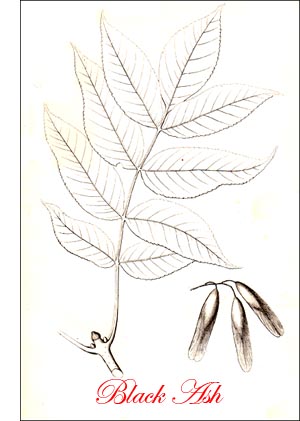Ashes and Fringe Tree
 FAMILY OLEACEAE
FAMILY OLEACEAEGenus FRAXINUS, Linn.
Valuable timber and ornamental trees. Leaves deciduous, pinnately compound, opposite. Flowers small, inconspicuous, in compound panicles; the two kinds, except in A, borne on separate trees. Fruit a dry seed, winged like a dart.
Ash trees are easily distinguished in the woods by the opposite arrangement of their pinnately compound leaves. Hickories, walnuts, and other trees with similar leaves will be found to have an alternate arrangement. The snugly fitting bark, broken into small, often diamond-shaped plates, gives the trunk of an ash a trim, handsome appearance in the winter woods. The seeds, winged and shaped like darts, are borne profusely, and are quite sufficient identification. No other tree bears a fruit that can be confused with this one.
There are thirty known species in the genus Fraxinus, half of which inhabit North America, covering all sections except the coldest. The Northern Hemisphere in the Old World is as well supplied. Cuba, northern Africa and the Orient have tropical species.
It is not so clear to ordinary people as it is to the botanists that the ashes belong to the olive family. If we knew all the tropical members of the group we might not be surprised. The relationship is established by morphological characters obvious only to trained observers.
The name ash is applied to several other kinds of trees. Mountain ashes belong to the rose family. Prickly ash belongs with the sumachs in the rue family. "Yellow ash" is a Tennessee name for Cladrastis lutea, the virgilia, a member of the locust family. The "hoop ash" of Vermont is the hackberry, a close relative of the elms.
Biltmore Ash Tree
Black Ash Tree
Blue Ash Tree
European Ash Tree
Flowering Ash Tree
Fringe Tree
Green Ash Tree
Oregon Ash Tree
Pumpkin Ash Tree
Red Ash Tree
Water or Swamp Ash Tree
White Ash Tree